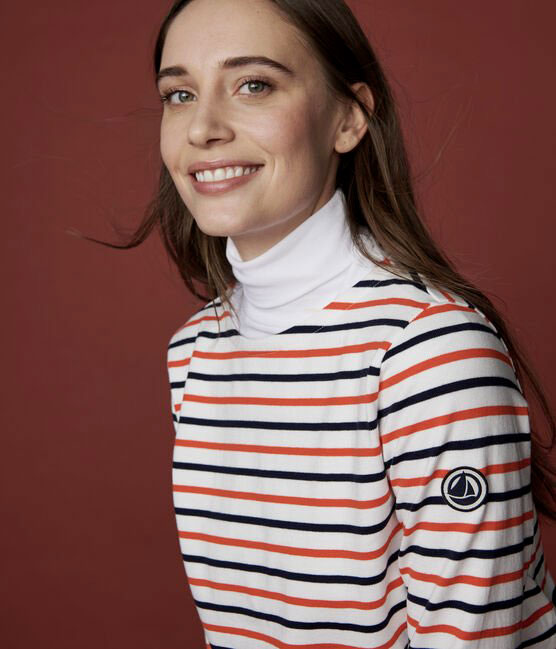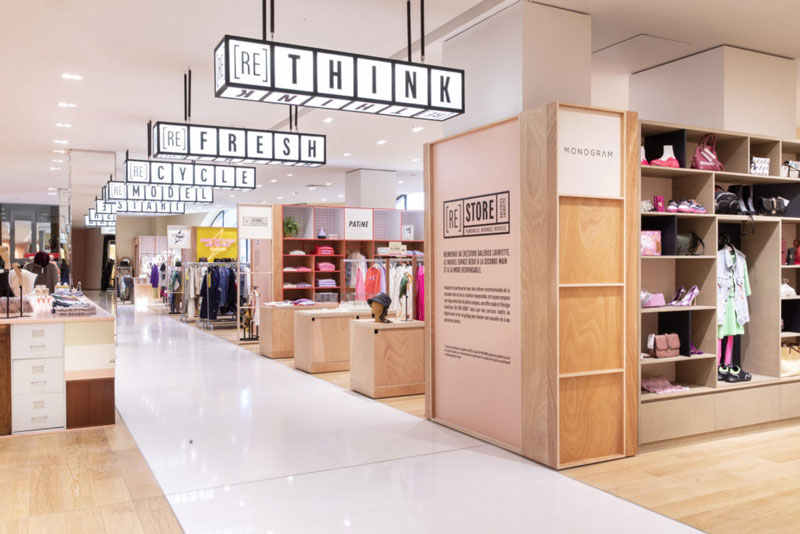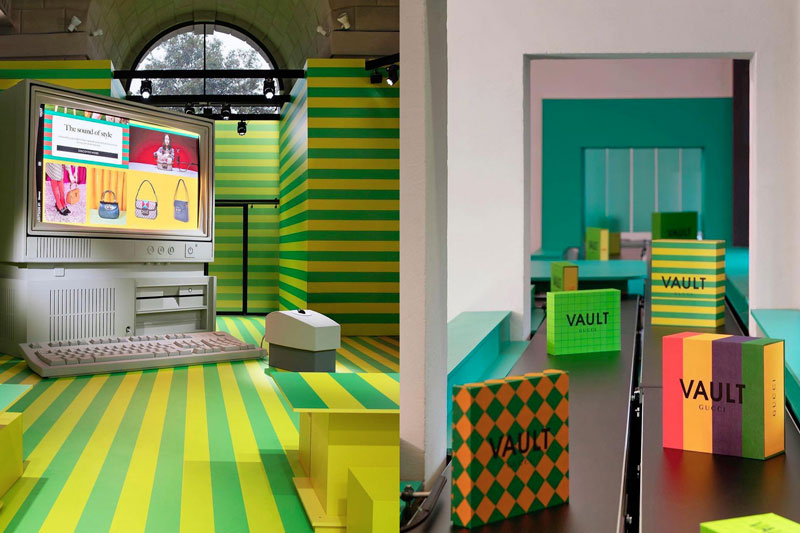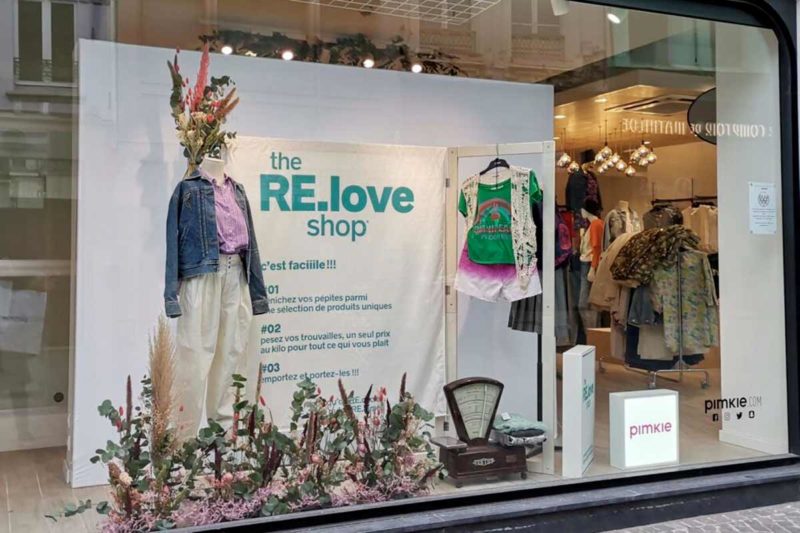The second-hand market is really booming. According to a study by Boston Consulting Group, it is even expected to grow by 15-20% per year over the next five years. To the point that ready-to-wear labels and big chain stores now have second-hand services of their own. We’re not yet at the point of opening a shopping centre entirely given over to second-hand goods, like in Sweden (ReTuna). But the offering is growing month after month.
Second-hand sites that have led to a boom in the market
The expansion of the second-hand market is in full swing, and the trend is particularly pronounced in the fashion industry. Thus, according to the Natixis Payments insights unit, in 2021 the number of second-hand clothing purchases was up by 140% versus 2019! Kantar, which carried out a study on the vintage fashion market for two years running, puts it at €1.16 billion. In France, more than one in four (29%) of those old enough to make their own purchases have bought themselves a second-hand item at least once.





Obviously, second-hand sites and apps account for much of this growing success. Thus, leboncoin attracts 29 million unique visitors each month. It’s the most-visited France-based site. As for Vinted, it’s France’s second most popular e-commerce site, according to Foxintelligence. In the space of a few years, the Lithuania-based peer-to-peer second-hand platform has become France’s third-ranked e-commerce site in terms of traffic. This places it behind Amazon and Cdiscount, but ahead of Fnac and Veepee (formerly Vente Privée). Our last example, Beebs, a site specialising in the sale and purchase of second-hand babies’ and children’s clothes, has registered 54% growth in sales since September.
There are two main reasons why consumers opt for second-hand goods. According to a study carried out in late 2020 for Oney bank, the price tag is the primary motivation for 86% of second-hand buyers in France, followed closely by environmental considerations at 78%.
Cyrillus and Petit Bateau – pioneers on their sites


On Vinted you’ll find thousands of listings for Petit Bateau and Cyrillus items. It occurred to these chain stores that it was perhaps best to organiser these sales themselves. Back in 2017, Petit Bateau opened a dedicated space in its app. The label acts as a host for peer-to-peer listings, and the parties sort out the payment and dispatch of the items between them. Only the label’s own products are offered, of course. Cyrillus uses the same concept with its “Second Story” [“Seconde Histoire”] service, a dedicated site that hosts peer-to-peer listings. Sellers have two options: receiving the proceeds in cash or as a Cyrillus gift card. To incentivise users to opt for the latter, Cyrillus adds an extra 50% bonus to the sales proceeds.
To start with, these labels offered this service to add interest to their communities and show that their items are of such high quality that they have several lives to live. A true sustainable fashion model, with the hope of channelling this chaotic market.
Mulliez group in front
Second-hand sales were soon up and running among the chain stores in the Mulliez empire.
Auchan opened the proceedings
The hypermarket chain trialled its first corners in February 2020 in five stores. They were so successful that during 2021, second-hand corners were rolled out to more than 120 Auchan branches. You’ll find all labels there, including Zara and H&M, at low prices. To make this happen, the chain teamed up with French start-up Patatam, which was set up in 2013. The company supplies Auchan with its clothing stock. It buys second-hand clothing from private individuals at very low prices, sorts them and then sells them at marked-up prices in supermarkets. Patatam also collects items handed over by customers. They can drop any brand of clothing off at Auchan. For each bag of clothes dropped off, they get a €5 voucher redeemable in the clothing department.
Specialist chain stores follow suit
After Auchan and Kiabi, chain stores Pimkie and Jules also opened corners, in partnership with Eureka Fripes. This is the leading international operator in terms of B-to-B second-hand clothing sales, and the one behind the Kiloshop concept. Pimkie drew inspiration from it, since it opted to sell second-hand women’s clothing by weight in its RE.love corners.
As for menswear chain store Jules, it chose the name Rewear for its spaces, the first of which was opened at the entrance of the Lille branch, followed by those in Nice, Angers, Reims, Brest and Lyon. These corners stock all brands of second-hand items (Nike, Champion, Adidas) in the denim, sportswear and streetwear categories. In addition, in 2020 the company entered into a partnership with Le Relais for clothing collection. The label’s customers can drop their cast-offs off into one of the 500 collection boxes placed in Jules branches.



Everyone wants a tab or corner of their own
Amid this popularity with consumers, a great many other chain stores such as Bocage, Gémo, Camaïeu, Promod, C&A and Eram have followed the second-hand trend by offering pre-worn clothes for sale. That cake is there for the taking, and so tempting that conventional chain stores no longer really have any choice but to take a slice.
Like Auchan, Leclerc, Cora and Carrefour have all set up second-hand corners in some of their branches. By 2020, Leclerc totalled 25 “Leclerc Occasion” outlets. The hypermarket chain had planned to open more than 100, but the Covid-19 pandemic scuppered its plans somewhat. Department stores Galeries Lafayette and Le Printemps recently opened spaces given over to vintage and second-hand items. The luxury segment is no exception, since labels like Burberry, J.M. Weston and Gucci also sell second-hand items.
Major online players, whether former catalogue sales firms or multi-brand stockists, are no exception either. In December 2020, La Redoute launched its own peer-to-peer swap shop for second-hand items. Called “La Reboucle”, it is available via its online portal or app. In the marketplace of its French site, the Spartoo fashion platform has several thousand second-hand clothing items listed, with the help of specialised supplier Patatam. Cdiscount has already launched such a service, as has Zalando, Europe’s leading online ready-to-wear fashion retailer.
Beyond clothes






However, the fashion industry is not the only one to embrace the trend. French DIY chain Leroy Merlin has also just launched a service called “Second-hand products”. [“Produits d’occasion”]. Sporting goods chain Decathlon has long been running the Trocathlon (an annual limited-time sports gear collection and sale). It has beefed up the scheme too, since over the past two years there have been more and more second-hand corners appearing in its stores. There is also a second-hand site, Occasions.Decathlon.fr,with many of the listings involving bikes. Mass retailer Système U is trialling the sale of second-hand items in its domestic appliance, housewares, media and multimedia aisles. Carrefour Occasion has been opened in partnership with Cash Converters and Cora, with Easy Cash. Delsey has launched the first ever platform given over to second-hand (reconditioned) suitcases and luggage. Since July, the Ikea France website has been listing second-hand furniture which can be ordered online and picked up in stores.
Bring footfall back into stores and generate sales
Big chain stores are struggling with falling footfall in favour of neighbourhood stores, click-and-collect-by-car services and online sales. And all of this has been exacerbated by Covid. So conventional retailers have no intention of letting Leboncoin or Vinted hoover up the second-hand market.
Winning over elderly consumers
Finding second-hand items in the same stores as new ones removes a hindrance for elderly consumers, who will never use a platform. They see brick-and-mortar stores as somewhat reassuring, and as vouching for quality and hygiene standards.
Generating footfall again
Having a second-hand corner is not an alternative to selling new items. It’s something that has to be done to increase footfall by attracting younger customers. Second-hand aisles encourage instore browsing. They even have customers visiting stores more: once to drop off an item, and again to buy something!
So the aim is about driving up footfall and sales, as well as boosting brand image. Every bit as much, or even more, than it is about reducing the environmental footprint.
Generating sales
Second-hand sales schemes are always viewed as a service. But this wish to embrace the circular economy often masks the less-than-virtuous aim of generating more sales, since the proceeds of sales can be paid in cash or vouchers, with a bonus of 20% at Kiabi, 25% at La Redoute, and 30% at Promod and Maison 123. And 60% of sellers take the voucher option. QED.
So it’s clear that the second-hand market is far from having more sustainable consumer behaviour that’s more respectful of the environment as its sole motivation. For consumers, the argument is often an economic one as much as an ecological one, in line with their purchasing power. For labels and chain stores, there are multiple arguments. For labels with a certain degree of prestige, it’s about proving the high quality of their items, which can live several lives. It is also about benefitting the brand image and channelling the sales of their products, both second hand and new. For mass retailers, the aim is to hoover up market share, not least to bring people back into hypermarkets. The latter have been a little neglected in these times of economic and public health crises. It is also about going out to get new consumers – fans of vintage goods at low prices – in the hope of turning them into loyal customers.







